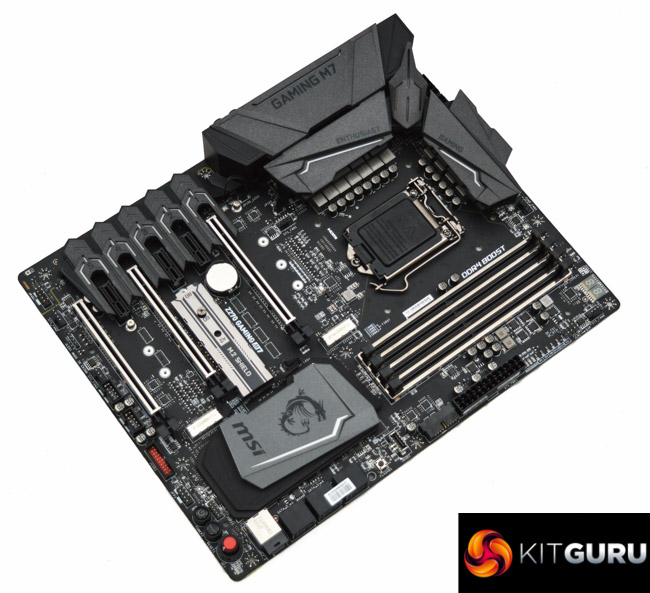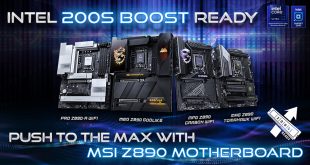The MSI Z270 Gaming M7 strikes us as being a well-rounded and competent motherboard for the high-end of the market with a number of interesting and innovative features. These include dual independent audio processors to supply the rear and front panel audio independently (and concurrently) and a front panel header for a USB 3.1 Type-C port. There's an M.2 Shield designed to reduce throttling of M.2 drives (though this is available on other models like the M5) and a suite of onboard overclocking features and buttons.
Thrifty consumers will most certainly assess the Gaming M7 as not doing enough to justify its additional cost of around £50 over the Gaming M5 and there is a certain degree of truth to that sentiment. MSI hasn't done a great deal of shouting about what makes the M7 the better purchase. Though the type of consumer likely to purchase the M7 over the M5 will have done the research into the subtle variations between the two and decided on whether or not the extra features bring value to their intended uses.

Those variations do indeed have muted impacts on the user experience as both motherboards are competent performers in their own right. The Gaming M7 is certainly the better bet for high-end overclocking, multi-GPU configurations and consumers with large SSD storage arrays, particularly M.2 NVMe SSDs or USB Type-C devices.
There are, however, some more general drawbacks to the MSI Z270 Gaming M7 that need consideration. Primarily, the RGB LED options are just not up to scratch against even cheaper motherboards, like the MSI Z270 Gaming Pro Carbon. MSI provides just 7 colours and 5 lighting effects and even parades this on the box as if it were a selling point. Full RGB would give the user customisation options in the way of at least hundreds of different colours, if not millions – 16.8 million to be specific.
The RGB issue is compounded by the fact the motherboard is awash with red lights – around the power button, on the rear I/O, near the memory lanes and the CPU socket. This in effect means you always have red, even if you pick blue or one of the other 6 colours. For the price point MSI should have done better.
We'd also consider the results of the M.2 Shield a mixed bag. On the one hand thermal throttling took longer to occur but on the other when it did occur it happened for a longer period. Perhaps airflow is to blame but the key consideration is that your mileage may vary, the M.2 Shield isn't a universal success for all different M.2 SSDs and operating environments.
The Z270 Gaming M7 does do enough to be worth purchasing, particularly where users aren't overly fussed about RGB functionality. Connectivity is well balanced and makes a lot of sense, the aesthetic of the board is clean and the slot shielding & overall build quality is reassuring. Performance across the full suite of benchmarks is strong and the building experience proved to be very trouble-free thanks to onboard power and reset buttons, debug LEDs and a debug code reader.
The CPU VRMs get a nice upgrade over the M5 and we found overclocking capability to be strong and voltage delivery to be stable and potent. MSI gives a plentiful amount of UEFI granularity with regards to choosing CPU voltage operation and Load Line Calibration.
Many of the positives discussed with the M7 still apply to the M5 so undoubtedly it's a tough call. Relative to the direct competition the M7 is priced somewhat awkwardly, at £240 | $240 | €280, which is towards the higher end of the market but it sits between many of its key rivals. It's more expensive than the ASUS ROG Maximus IX Hero and Gigabyte AORUS Z270X-Gaming 7 but cheaper than the ASUS ROG Maximus IX Apex and ASRock Fatal1ty Z270 Gaming i7.
On it's own merits the MSI Z270 Gaming M7 has enough going for it that most consumers would be satisfied with their purchase which performs well in the face of strong competition. If the budget is tighter then the MSI Z270 Gaming M5 definitely makes more sense but the Gaming M7 is worth the extra spend if you are able to make use of its additional features.
The MSI Z270 Gaming M7 is available at Overclockers UK for £247.99. MSI’s standard warranty duration for this product is 3 years.
Discuss on our Facebook page, over HERE.
Pros:
- Ample storage options for SSD fans
- Shielded PCIe and DDR4 slots
- Onboard power buttons
- OC-friendly tools and features
- Well-rounded I/O
- Independent front and rear audio processors
- Front Panel USB Type-C header
Cons:
- Non-configurable red LEDs that interrupt the aesthetic
- Lighting colour and pattern options are too restricted
- M.2 Shield results mixed
- Pricing could be more competitive
KitGuru says: A competent and well-rounded performer that is loaded with a number of interesting features, the MSI Z270 Gaming M7 is a worthy option in its price segment.
 KitGuru KitGuru.net – Tech News | Hardware News | Hardware Reviews | IOS | Mobile | Gaming | Graphics Cards
KitGuru KitGuru.net – Tech News | Hardware News | Hardware Reviews | IOS | Mobile | Gaming | Graphics Cards





The first motherboard to have two audio codecs? We take a look at MSI’s intriguing Z270 Gaming M7
Bah you got me, that was verging on clickbait ; ) I was expecting a separate page filled with amazing audio info but I had to hunt through for titbits and I’m still non the wiser.
My theory is all of the single codec Z170 motherboards are only Amplified to one of the channels, in my case with the Maximus Gene to the front panel, this motherboard appears to be amplified to the front and rear channels, maybe for speakers/headphones or headphones/headphones i’m thinking VR without having to reach around and swap headsets all the time. Just a thought.
I have this motherboard and it is absolutely awesome. The double audio codecs is great, but I use a soundblaster card anyway which is still better. I am just very much impressed overall with this board, its looks, and it features. It feels like a solid high quality product. Sure the M.2 Thermal Shield is a gimmick, but shouldn’t really be considered a negative. I just took it off and used that slot for a Samsung 950 Pro. With good case air flow you won’t have any throttling issues anyway. I never have.
Apologies, not my intention! Yes the only amplified channel is usually the headphone out port (green when colour codec) since only headsets usually need the amplification (or significantly benefit from it). This is indeed amplified for the front and back headset ports since the ALC1220 codec has built in amplifiers meaning there are two on this, one per codec.
No apologies needed I was just joking. Yeah that was my theory, maybe they are crazy enough to think people want two sets of headphones at once. Like the person playing VR and the person watching on a monitor or maybe for the gamer with a short headphone cable and VR who doesn’t want to swap his headset back to front all the time. I’m really clutching at straws here.